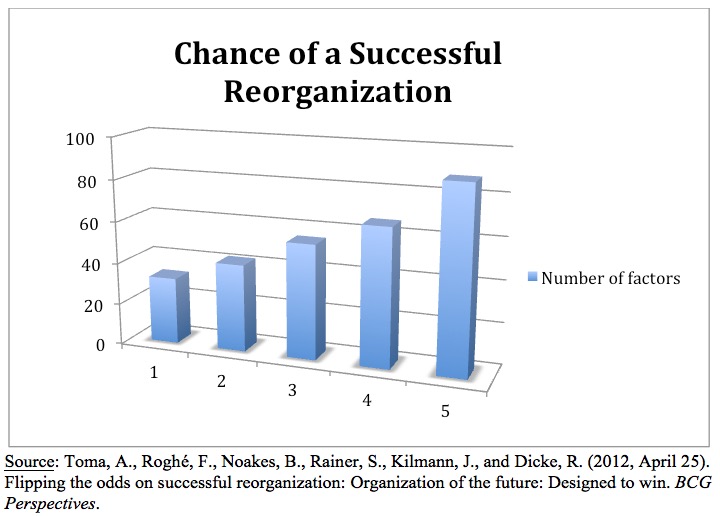Few activities are as maddening as a reorganization. In A Passion for Leadership: Lessons on Change and Reform from Fifty Years of Public Service, Robert Gates explained:
One strategy new leaders often use in reform initiatives is reorganizing the bureaucracy. But all too often, they confuse organizational and name changes with real change. They believe that moving the boxes around on the organization chart, changing the lines for who reports to whom, making dotted lines into solid lines, and the like will fix problems and represent real change. They are nearly always wrong. When you get a new boss who is bent on changing things by changing boxes, it usually means he isn’t really serious about change or he doesn’t understand how to lead it. If a leader wants real change, he must realize the main target is how people do their work, not where. How you make people more efficient and productive, more effective, more responsive, more open-minded, better at their jobs, is little affected by the placement of their organization on the chart….
Rearranging the organizational boxes, especially if it involved physical relocations, also is enormously distracting to an organization. Employees will be preoccupied with whether their personal and office status has improved or declined in the reorganization—as well as whether in the game of bureaucratic musical chairs they might find themselves without a job….
Whether in the public or the private sector, try to leave the boxes, both actual and organizational, alone unless absolutely necessary.[1]

Gates is not alone in his assessment. Former Avis CEO, Robert Townsend, included the following gem in Up the Organization: “I was to learn later in life that we tend to meet any new situation by reorganizing; and what a wonderful method it can be for creating the illusion of progress while producing confusion, inefficiency, and demoralization.”[2]
In Management, Drucker named the disease “organizitis,” and described it as a sort of hypochondria. He explained, “Reorganization is going on all the time. At the first sign of any trouble, a cry goes up for the ‘organization doctors,’ whether outside consultants or internal staff. And no organizational solution ever lasts long.” He concluded, “Organization changes should not be undertaken often and should not be undertaken lightly. Reorganization is a form of surgery, and even minor surgery has risks.”[3]
Reorganization Usually Doesn’t Work
Why the sour assessment of reorganization?
The reason is simple. Reorganizations rarely work. I have observed a number of them up close and at a distance, and nearly all were disasters.
Yet, while you are going through one, company leaders talk about it in glowing terms. You never hear anything about the difficulties. To hear company leaders talk, if you did not know better, you would wonder why they haven’t launched this master-stroke before. But there is no quick fix for what ails us. Why do we continue to act in ineffective ways?
In fairness, reorganization is sometimes necessary, but they tend to be the “Hail Mary pass” in the executive’s playbook. When we have no better strategy, we reorganize.
But if reorganizations are so often ineffective, what should we do?
What Works
Gates answered the question. Focus on how the work is done, not where. Focus on efficiency, not who reports to whom. Focus on alignment with the mission rather than the number of subordinates on the organizational chart.
This perspective was confirmed by academic research on reorganizations. In 2012, the Boston Consulting Group issued a report that provided an answer. Their sample study found that 90% of large companies recently went through some sort of restructuring. “Yet as common as reorganizations have become, what’s even more common is their high failure rate. Less than half of all reorganizations in our survey were considered successes.”[4]
The authors of the study identified six critical factors that increase the odds of a successful reorganization.
- Synchronize design with strategy: This means that the reorganization follows a change in strategy. The organization is re-aligned to do more of one thing and less of another in accordance with the new focus.
- Clarify roles and responsibilities: Specific roles, levels of authority, and accountability must be made clear, and these components must support the mission and the new strategy.
- Deploy the right leaders and the right capabilities: Much of a reorganization’s success depends on a capable leader. The capable leader (one who can lead others well) must also be competent (one who understands what needs to be done). If the chosen leader does not have both leadership capability and technical competence, you are not likely to be successful.
- Design layer by layer, not just top-down: An approach that considers how the redesign will affect each level affected will be more successful than a change directed from the top. Inviting leaders at each level to participate in the redesign yields a success-to-failure rate of 4:1 (double the top-down) success rate. This is because such a thoughtful design achieves greater alignment and buy-in, blunting the negative effects of future uncertainty.
- De-risk execution: Reorganization must be carefully thought through, planned, and executed in a transparent system where a) everyone affected knows what is happening and b) where course corrections can be made in the process. A successful reorganization will never be a haphazard process. If it does, the efficiency gains on paper will be wiped out by demotivation and marked by departures (mental or physical).
- Don’t wait for a crisis to reorganize: Reorganizing because growth led to a dismal success-to-failure rate of 1:2, but reorganizations for the sake of organizational strategy, that were not driven by a crisis, had a much higher success rate (21:1) because the change was mission-driven and properly resourced. Unfortunately, only 10 percent of reorganizations take place during these periods of strength. The majority of reorganization efforts take place because things are not working well.
The authors of the study concluded,
For organizations with only one success factor in place, the rate of success was 32 percent. But with each additional factor, the success rate jumped proportionately; 88 percent of organizations that had five or more elements in place reported complete success.[5]
If you are going through a reorganization, the good news is that you now have predictive power. Add up the factors to determine your odds.
- Is it for a strategic purpose or is it because we do not know what else to do?
- Are your new roles clear and connected to the mission or are they an afterthought based on the reorganization?
- Is your new leader capable (to lead) and competent (technically)?
- Were you invited into the redesign process or was it designed by the executives with little design input by those affected?
- Is it being carefully executed with the ability to make course corrections as necessary?
- Is it being done during the good times to enhance effectiveness based on organizational strategy or is it done in reaction to a crisis?
Add up your total. If you counted one factor, your odds of success are 32%. If two, your odds are 42%. If three, 55%. If four, 66%. If you have 5 or 6 factors, 88%. You now know your odds. The next question is what you will do with that information.
-Darin Gerdes
——-
[1] Gates, R. M. (2016). A passion for leadership: Lessons on change and reform from fifty years of public service. New York: Alfred A. Knopf (pp. 58-59).
[2] Townsend, R. (1970). Up the organization. New York: Knopf. (p. 111).
[3] Drucker, P. F. (1974). Management: Tasks, responsibilities, practices. New York: Routledge. (p. 464)
[4] Toma, A., Roghé, F., Noakes, B., Rainer, S., Kilmann, J., and Dicke, R. (2012, April 25). Flipping the odds on successful reorganization: Organization of the future: Designed to win. BCG Perspectives. Retrieved from https://www.bcgperspectives.com/content/articles/change_management_organization_design_flipping_the_odds_for_successful_reorganization/
[5] Flipping the odds on successful reorganization: Organization of the future: Designed to win. BCG Perspectives. Retrieved from https://www.bcgperspectives.com/content/articles/change_management_organization_design_flipping_the_odds_for_successful_reorganization/
______________

Dr. Darin Gerdes is an Associate Professor of management in the School of Business at Charleston Southern University. All ideas expressed on www.daringerdes.com are his own.
This post was originally created for Great Business Networking (GBN), a networking organization for business professionals where Dr. Gerdes is the Director of Education.
______________



